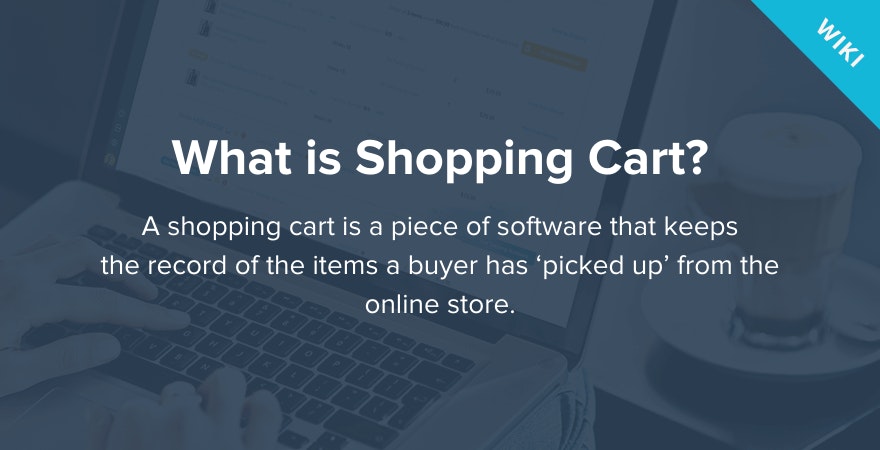
Shopping Cart



What is Shopping Cart?
A shopping cart is a piece of software that keeps the record of the items a buyer has ‘picked up’ from the online store. Acting as an online store’s catalog, the eCommerce shopping cart enables consumers to select products, review what they selected, make modifications or add extra items if needed, and purchase the products.
Types of Shopping Carts
Every online store must have the shopping cart functionality to be able to sell products to customers. Essentially, there are two types of shopping carts – hosted and self-hosted shopping carts.
- Hosted shopping carts are off-the-shelf solutions managed by the company who created them. What this means is that all you need to do to set up your store is to sign up with your chosen host and you’re good to go. You can use pre-made website templates to set up a completely new store or simply add purchase buttons to your existing website and start selling immediately. By far the most popular hosted shopping cart is Shopify, but there are plenty of other options, too.
- Self-hosted shopping carts are 100% customizable shopping solutions that you host on your own server. This simply means that you download the software and run it yourself.
What is Shopping Cart Abandonment?
Shopping cart abandonment occurs when customers add items to their shopping cart but don’t complete the purchase. It is one of the biggest issues plaguing eCommerce entrepreneurs, as roughly of shopping carts are abandoned worldwide.
In order to tackle the whopping shopping cart abandonment rate, marketers need to understand the underlying reasons and drivers behind this decision. The most common reason for shopping cart abandonment is that people were simply browsing for options. According to a recent study, the most commonly stated reasons for abandonments during checkout include:
- Unexpected extra costs that are too high (shipping, tax, fees)
- Merchant not providing the option of guest checkout and asking to create an account
- The checkout process takes too long or is too complicated
- The merchant doesn’t show the total order cost upfront
- Website has bugs or crashes during checkout
- Website seems fishy, customers have payment security concerns
- Delivery is too slow
- Disappointing returns policy discourages customers from buying
- Merchant does not provide enough payment methods
- Merchant does not provide a mobile-friendly payment option
- Consumer’s credit card is declined
- Consumer finds a better deal elsewhere
- Consumer is only browsing or doing research
Responding to Shopping Cart Abandonment?
Although not a definitive list, it gives a pretty good insight into the complicated issue of shopping cart abandonment. Each reason listed above calls for a different solution and eCommerce marketers need to think about and address each and every one of them in a smart and non-intrusive way.
For example, here are a few methods to combat the most popular cart abandonment reasons:
- Problem: customers don’t want to pay unexpected extra costs
Solution: communicate all additional costs upfront and avoid any hidden or small-print charges. There’s nothing more frustrating for a consumer than to go through all the checkout process only to discover they’re hit by outrageous shipping charges. They will never come back. - Problem: customers don’t want to create a new account in order to checkout
Solution: although collecting data about your customers is a critical component of your store’s success, do not force buyers to create an account with you or you’ll end up losing them. The best solution is to provide a guest checkout or social logins (Facebook, LinkedIn, Gmail, etc) option alongside your usual “create an account” solution and let the customer choose. You can always ask for more details later on. - Problem: customers find the checkout process too long
Solution: you may not be able to actually reduce the number of steps in the checkout process, but you can eliminate shopper frustration by adding a visually appealing progress bar to your checkout page to provide constant progress updates and make the customer feel in control.
In order to reduce your shopping cart abandonment rate, you must identify the main drivers and friction points first. There are many eCommerce statistics that can shed light on possible issues, but you should start by examining your store’s conversion pathways in Google Analytics and visually mapping out the flow of your site.



Want to Learn More?
- How to Use Google Analytics for Your Ecommerce Business
- 10 Ways to Turn Site Visitors Into Email Subscribers for Your Online Store
- How to Recover Abandoned Carts Easily
- The Complete Guide To Marketing Channels
Is there anything else you’d like to know more about and wish was included in this article? Let us know!